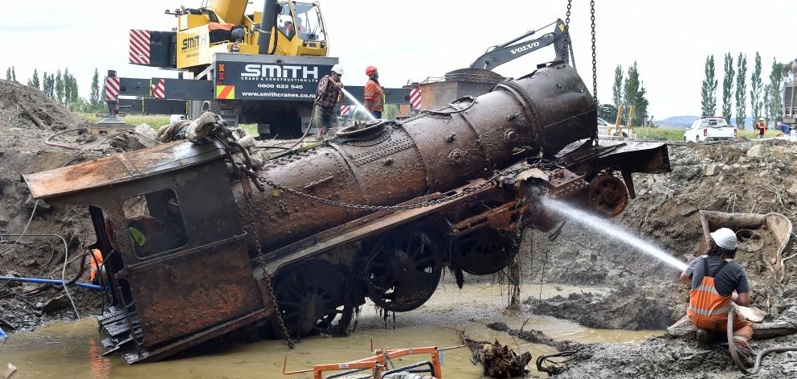
It was as though history was being made.
When an 1885 V-class steam locomotive and a coal tender were drawn from the Oreti River in Southland yesterday it seemed a new chapter would be added to an old story.
‘‘In some ways we are rewriting history, but in another way they are returning home to where they used to operate,’’ Lumsden Heritage Trust chairman John Titter said yesterday.
Emotions were high riverside as the six-year project to rescue the machine from the water finally bore fruit.
Two locomotives and a coal tender were abandoned to the river in 1927.
Mr Titter believed the locomotives — V126, which was recovered, and V127, which was too damaged to be moved — were the most intact of their kind in the world.
New Zealand Rail ordered the pair in about 1877 and they were specifically made for country’s railway lines.
They were manufactured in Manchester, England.
‘‘Actually, it was the New Zealand guys that designed it to haul bigger amounts of freight, longer trains and have more power to meet that demand.
‘‘And after all that time, they were found to be too heavy for the line.’’
New Zealand Rail did not accept delivery until the locomotives were made lighter, Mr Titter said.
‘‘They were five and a-half tonnes overweight, excluding the tenders. It was massive.’’
He believed the locomotives were sent to Southland and Otago, but Manawatu also had few of them at the time.
‘‘They served New Zealand lines for about 30 years — they actually did quite a good service.’’
They were dumped in the river in 1927, when they had become simply surplus to requirements.
‘‘New Zealand Rail needed to get rid of a lot of gear and did not know what to do with it,’’ he said.
‘‘Because of the low price of scrap metal after the First World War, someone came up with this idea of putting them in as flood protection.’’
‘‘They had this big crane in one side of the track — which was a steam crane
... They just lifted and rolled them in.’’
After the recovery operation, Mr Titter was surprised by the condition of what emerged.
‘‘The cab is slightly bent and quite loose at the moment, but they were in a very good shape if you consider they have been rolled into the river and were there for 93 years.’’
The locomotive and coal tender would be displayed on a specially built track at the Lumsden Railway Precinct.
‘‘She [the locomotive] is returning home,’’ he said.
It was as though history was being made.
When an 1885 V-class steam locomotive and a coal tender were drawn from the Oreti River in Southland yesterday it seemed a new chapter would be added to an old story.
‘‘In some ways we are rewriting history, but in another way they are returning home to where they used to operate,’’ Lumsden Heritage Trust chairman John Titter said yesterday.
Emotions were high riverside as the six-year project to rescue the machine from the water finally bore fruit.
Two locomotives and a coal tender were abandoned to the river in 1927.
Mr Titter believed the locomotives — V126, which was recovered, and V127, which was too damaged to be moved — were the most intact of their kind in the world.
New Zealand Rail ordered the pair in about 1877 and they were specifically made for country’s railway lines.
They were manufactured in Manchester, England.
‘‘Actually, it was the New Zealand guys that designed it to haul bigger amounts of freight, longer trains and have more power to meet that demand.
‘‘And after all that time, they were found to be too heavy for the line.’’
New Zealand Rail did not accept delivery until the locomotives were made lighter, Mr Titter said.
‘‘They were five and a-half tonnes overweight, excluding the tenders. It was massive.’’
He believed the locomotives were sent to Southland and Otago, but Manawatu also had few of them at the time.
‘‘They served New Zealand lines for about 30 years — they actually did quite a good service.’’
They were dumped in the river in 1927, when they had become simply surplus to requirements.
‘‘New Zealand Rail needed to get rid of a lot of gear and did not know what to do with it,’’ he said.
‘‘Because of the low price of scrap metal after the First World War, someone came up with this idea of putting them in as flood protection.’’
‘‘They had this big crane in one side of the track — which was a steam crane
... They just lifted and rolled them in.’’
After the recovery operation, Mr Titter was surprised by the condition of what emerged.
‘‘The cab is slightly bent and quite loose at the moment, but they were in a very good shape if you consider they have been rolled into the river and were there for 93 years.’’
The locomotive and coal tender would be displayed on a specially built track at the Lumsden Railway Precinct.
‘‘She [the locomotive] is returning home,’’ he said.
Take your Radio, Podcasts and Music with you









